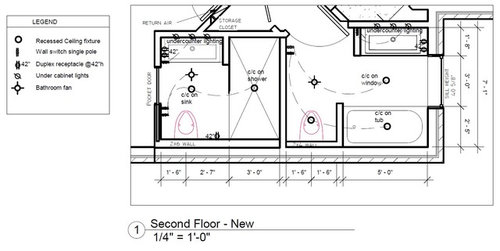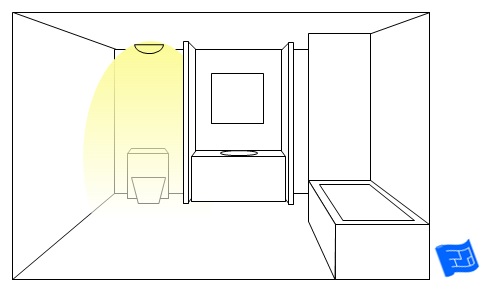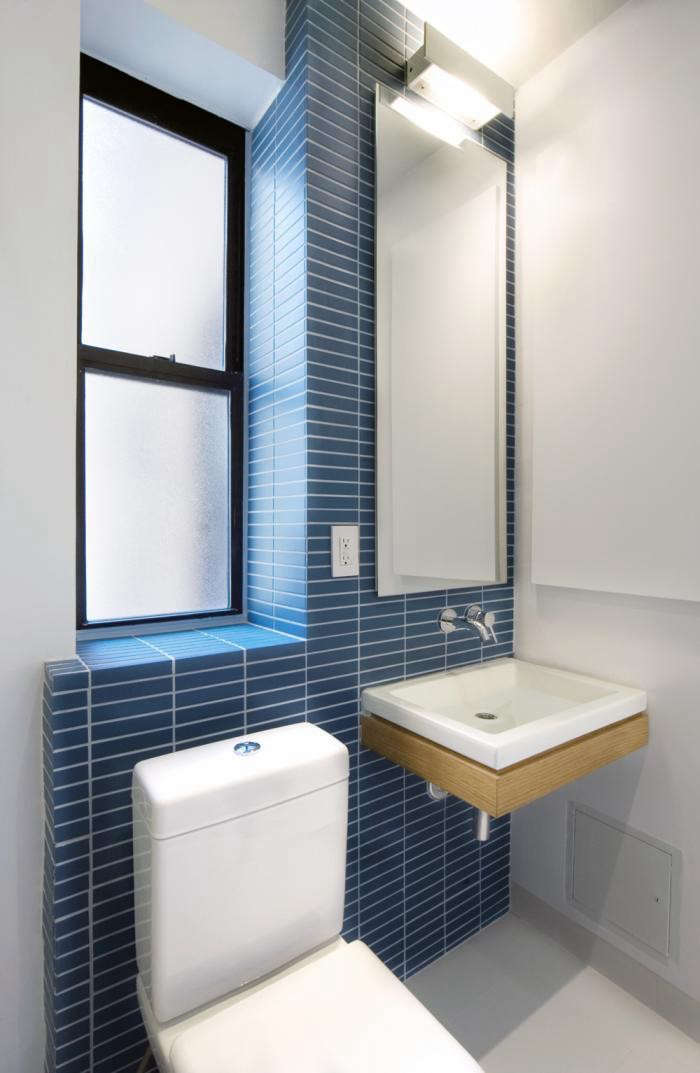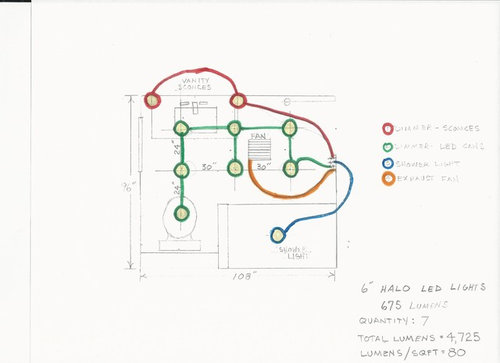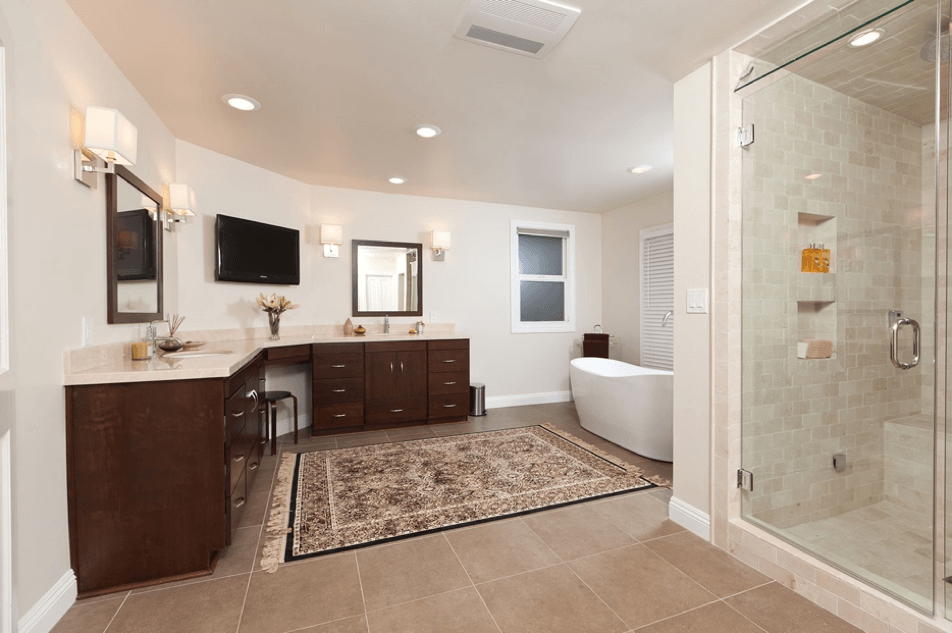When it comes to designing the perfect lighting layout for a small bathroom, careful consideration of both functionality and aesthetics is paramount. Small spaces present unique challenges and opportunities, requiring a strategic approach to ensure the space feels open, bright, and welcoming. By thoughtfully layering different types of lighting, you can create a bathroom that is both practical and stylish.
To begin with, the foundational element of a small bathroom lighting layout is ambient lighting. This general illumination ensures the space is adequately lit and provides a base layer of light. Recessed ceiling lights are a popular choice for ambient lighting in small bathrooms. These fixtures are unobtrusive and can be strategically placed to evenly distribute light throughout the room. Alternatively, a flush-mount ceiling light can also serve as a primary light source, providing broad illumination without taking up much space.
Task lighting is another crucial aspect of a well-designed bathroom. In small bathrooms, it’s essential to have focused lighting around the vanity area for activities such as shaving, applying makeup, or brushing teeth. Sconces mounted on either side of the mirror offer balanced illumination, eliminating shadows on the face. If side sconces are not feasible, an overhead light above the mirror can also provide effective task lighting. The key is to ensure the light is bright and evenly distributed to avoid harsh shadows.
Accent lighting adds depth and dimension to a small bathroom, creating visual interest and highlighting architectural features or decor. This can be achieved through various methods, such as under-cabinet lighting, which not only accentuates cabinetry but also provides additional task lighting on countertops. Another option is to use LED strip lights along the baseboards or behind mirrors to create a subtle glow that enhances the ambiance of the room.
Incorporating natural light is a game-changer for small bathrooms. If your bathroom has a window, maximize the natural light by keeping window treatments minimal or opting for sheer curtains that allow light to filter through while maintaining privacy. Skylights are another excellent option for bringing natural light into the bathroom without sacrificing privacy. Natural light not only makes the space feel larger but also positively impacts your mood and well-being.
Choosing the right light bulbs is equally important in a small bathroom lighting layout. LED bulbs are a smart choice due to their energy efficiency, longevity, and range of color temperatures. For general and task lighting, opt for bulbs with a color temperature of around 2700K to 3000K, which provides a warm, inviting light that is flattering to skin tones. For accent lighting, you can experiment with different color temperatures to create the desired effect.
Dimmers are a valuable addition to small bathroom lighting. They allow you to adjust the light levels according to your needs and preferences, creating a more versatile and comfortable environment. For example, you can have bright lighting for morning routines and dimmed lighting for a relaxing bath in the evening. Installing dimmer switches can significantly enhance the functionality and ambiance of your bathroom.
Reflective surfaces play a significant role in amplifying light in small bathrooms. Mirrors, glossy tiles, and metallic fixtures can reflect light and make the space appear larger and brighter. A large mirror above the vanity not only serves a practical purpose but also reflects both natural and artificial light, enhancing the overall brightness of the room. Consider mirrored cabinets or multiple mirrors to further boost the reflective effect.
The color scheme of your bathroom also influences how light is perceived. Lighter colors reflect more light, making the space feel more open and airy. White or light-colored walls, tiles, and fixtures can help maximize the effect of your lighting layout. However, incorporating contrasting darker elements can add depth and visual interest without overwhelming the space.
Proper ventilation is often overlooked but crucial in a small bathroom. Excess moisture can lead to issues such as mold and mildew, which can impact the performance and longevity of your lighting fixtures. An effective exhaust fan will help manage humidity levels, protecting your lighting investment and ensuring a healthy bathroom environment.
In small bathrooms, every inch counts, so it’s essential to choose fixtures that are proportionate to the space. Oversized light fixtures can overwhelm a small bathroom and make it feel cramped. Opt for sleek, compact fixtures that provide ample light without taking up too much visual space. Recessed lights, slim sconces, and low-profile ceiling lights are excellent choices for small bathrooms.
When planning your lighting layout, consider the placement of light switches for convenience and accessibility. Ideally, light switches should be located near the entrance of the bathroom and easily reachable from different areas of the room. This ensures you can quickly and easily control the lighting as needed.
Layering different types of lighting is key to a well-balanced bathroom lighting layout. Combining ambient, task, and accent lighting allows you to create a space that is functional for various activities while also being aesthetically pleasing. Each layer of light serves a specific purpose, and together they create a harmonious and versatile lighting scheme.
Safety is a crucial consideration when selecting lighting for a bathroom. Ensure that all fixtures are rated for use in damp or wet environments to prevent electrical hazards. This is especially important for fixtures installed near showers, bathtubs, or sinks. Look for products labeled as suitable for bathroom use to ensure they can withstand the conditions of a humid environment.
Finally, personal style should not be overlooked. The lighting fixtures you choose can reflect your taste and enhance the overall design of your bathroom. Whether you prefer a modern, minimalist look or a more traditional, ornate style, there are lighting options available to complement your aesthetic. Selecting fixtures that align with your design vision will help create a cohesive and inviting bathroom.
Common Mistakes to Avoid
When designing a lighting layout for a small bathroom, there are several common mistakes to avoid to ensure the space is both functional and attractive. One frequent error is neglecting the importance of layering light. Relying solely on one type of lighting, such as a single overhead light, can result in a space that feels flat and lacks dimension. Incorporating a mix of ambient, task, and accent lighting will create a more balanced and versatile environment.
Another mistake is choosing fixtures that are too large for the space. Oversized lights can overwhelm a small bathroom, making it feel cluttered and cramped. Opt for compact, low-profile fixtures that provide sufficient illumination without dominating the room. Additionally, ensure the fixtures are proportionate to the size of your bathroom to maintain a harmonious look.
Ignoring the need for proper task lighting is a common oversight. Poorly lit vanity areas can make daily grooming tasks difficult and frustrating. Ensure that you have adequate lighting around mirrors and sinks to provide clear, shadow-free illumination. Side-mounted sconces or an overhead light above the mirror are effective solutions.
Failing to consider the color temperature of light bulbs can also impact the overall feel of your bathroom. Bulbs with a color temperature that is too cool can create a harsh, clinical atmosphere, while bulbs that are too warm may not provide enough clarity for tasks. Aim for a balance with bulbs around 2700K to 3000K for a warm yet clear light.
Forgetting about dimmers can limit the functionality of your lighting. Dimmers allow you to adjust the light levels according to your needs and preferences, creating a more flexible and comfortable space. Installing dimmer switches can enhance the versatility of your bathroom lighting and improve the overall user experience.
Last, not considering the impact of reflective surfaces and colors can lead to a bathroom that feels darker and smaller than it is. Utilizing mirrors, glossy tiles, and light colors can help amplify the available light, making the space feel brighter and more open. Reflective surfaces bounce light around the room, enhancing the effectiveness of your lighting layout.
What is the best type of lighting for a small bathroom?
The best type of lighting for a small bathroom involves a combination of ambient, task, and accent lighting. Ambient lighting provides general illumination, while task lighting focuses on specific areas like the vanity for grooming activities. Accent lighting adds depth and highlights architectural features or decor. Recessed ceiling lights, sconces, and under-cabinet lights are all excellent choices for a layered lighting approach in a small bathroom. This combination ensures the space is well-lit, functional, and visually appealing.
How can I make my small bathroom appear larger with lighting?
To make a small bathroom appear larger with lighting, use a combination of reflective surfaces, light colors, and strategic lighting placement. Mirrors are particularly effective at reflecting light and creating the illusion of more space. Glossy tiles and metallic fixtures also help bounce light around the room. Light colors on walls, ceilings, and fixtures can enhance the brightness of the space. Additionally, using recessed lights or wall-mounted fixtures can free up visual space and reduce clutter, making the bathroom feel more open and airy.
What are the benefits of using LED bulbs in bathroom lighting?
LED bulbs offer several benefits for bathroom lighting. They are highly energy-efficient, consuming less electricity and reducing energy bills. LED bulbs have a long lifespan, meaning they need to be replaced less frequently, which is convenient and cost-effective. They also come in a range of color temperatures, allowing you to choose the perfect light for your bathroom. LED bulbs produce less heat than traditional bulbs, which can help keep the bathroom cooler and more comfortable. Their durability and efficiency make them an excellent choice for any bathroom lighting layout.
Should I use dimmer switches in my small bathroom?
Yes, using dimmer switches in your small bathroom is highly recommended. Dimmers allow you to adjust the light levels to suit different needs and times of day, providing greater flexibility and comfort. For instance, you can have bright lighting for morning routines and softer, dimmed lighting for a relaxing evening bath. Dimmers also help save energy by reducing the amount of electricity used when full brightness is not necessary. They enhance the overall functionality and ambiance of your bathroom, making them a valuable addition to your lighting layout.
How do I choose the right light fixtures for a small bathroom?
Choosing the right light fixtures for a small bathroom involves considering both functionality and style. Opt for compact, low-profile fixtures that provide adequate illumination without overwhelming the space. Recessed lights, slim sconces, and flush-mount ceiling lights are excellent choices. Ensure that the fixtures are proportionate to the size of your bathroom and complement its overall design. Additionally, select fixtures rated for wet environments to ensure safety and durability. The right fixtures should enhance both the practicality and aesthetic appeal of your bathroom.
Can natural light be integrated into a small bathroom lighting layout?
Yes, integrating natural light into a small bathroom lighting layout can significantly enhance the space. Maximizing natural light makes the bathroom feel larger and more inviting. If your bathroom has a window, use sheer curtains or blinds that allow light to filter through while maintaining privacy. Skylights are another excellent option for bringing natural light into the bathroom without compromising privacy. Natural light not only brightens the space but also has positive effects on mood and well-being. Combining natural light with artificial lighting creates a balanced and welcoming environment in your small bathroom.
Related articles:
- Antique Bathroom Light Fixtures
- Bathroom Lighting Inspiration
- Modern Bathroom Lighting
- Bathroom Lighting Above Vanity
- Small Bathroom Lighting Layout
- Rustic Bathroom Sconce Lighting
- Farmhouse Style Bathroom Light Fixtures
- Modern Bathroom Lighting Design
- Bathroom Ceiling Lighting Fixtures
- Modern Bathroom Lights Over Mirror


